Trauma is a word that we often hear but may not fully understand. It’s something that can happen to anyone, and it can have a lasting impact. Unfortunately, trauma can also be passed down from one generation to the next. This is what’s known as the cycle of trauma.
When someone experiences a traumatic event, it can change the way they see themselves and the world around them. They may start to feel like they’re not safe and that they can’t trust anyone. This can lead to problems in their relationships and their everyday lives.
If this cycle isn’t broken, it can be passed down to their children and grandchildren. However, there is hope. With the right support, people can heal from trauma and break the cycle.
If you are interested in figuring out the cycle of trauma and how to effectively heal from it, continue reading.
What Is Trauma
Trauma is a word used often, but what does it actually mean? Trauma is a response to a deeply distressing or disturbing event. It is often characterized by feelings of fear, helplessness, and isolation. Trauma can also lead to physical symptoms such as sleep problems, headaches, and stomach problems.
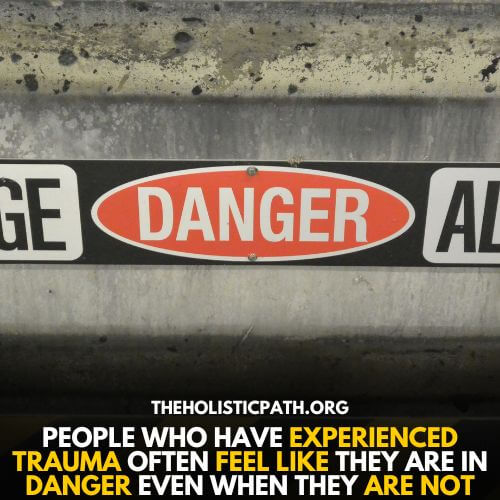
People who have experienced trauma often feel like they are in danger even when they are not. This can lead to anxiety, depression, and post-traumatic stress disorder. Trauma can have a lasting impact on someone’s mental and physical health.
The Cycle Of Trauma
Trauma can be a very difficult thing to overcome. It can often feel like it’s impossible to break the cycle of pain and suffering that trauma can cause. The cycle of trauma refers to the way that trauma can often repeat itself over and over again and affect people’s lives. It can create a vicious cycle where people feel stuck in a cycle of pain and suffering.
This happens because the trauma can cause people to feel unsafe or threatened, which can lead to them feeling overwhelmed or out of control. This in turn can lead to them feeling isolated and disconnected from others, which can then lead back to feeling unsafe or threatened.
Generational Trauma
Trauma is a funny thing. It doesn’t just happen once and then goes away. Instead, it’s like a ripple effect that can reverberate through generations. Each generation shares the weight of the trauma experienced by the previous one. And as new traumas are added to the mix, the burden only gets heavier.
This is sometimes referred to as the “cycle of trauma.” It’s a vicious cycle that can be passed down from one generation to the next. And it often takes someone brave enough to break the cycle before it can be stopped.
Generational trauma is a real phenomenon with far-reaching consequences. It’s important to be aware of it and to understand how it can impact people. If we can educate ourselves and others about this issue, maybe we can start to break the cycle of trauma and give future generations a chance at a better life.
How Does The Cycle Of Trauma Work
Trauma is often passed down from generation to generation. It can cause problems in relationships, mental and physical health, and overall functioning. There are 5 phases to the cycle of trauma:
1. Individual Develops A Lack Of Trust
Trust is one of the stepping stones for any relationship, be it personal or professional. But many people who have experienced trauma develop a lack of trust.
This is the first phase of the cycle of trauma. This lack of trust can manifest in a number of ways, such as difficulty trusting others, constantly feeling on guard, or being quick to anger.
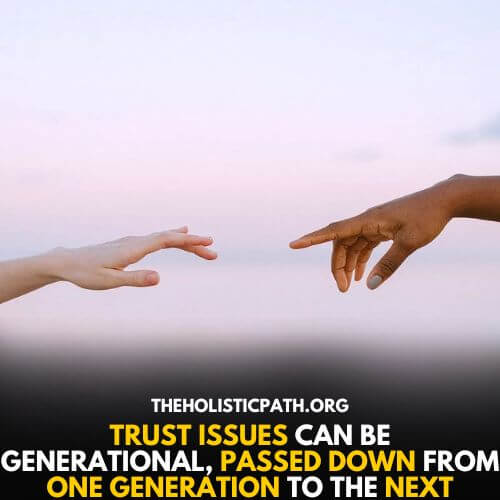
There are a number of reasons why someone who has experienced trauma might struggle to trust others. They may have had their trust betrayed in the past, or they may have learned that it is not safe to let down their guard. In some cases, trust issues can be generational, passed down from one generation to the next. When someone learns that distrust is a defense mechanism, it can be difficult to break out of that pattern.
2. Developing Bullying Behavior
Developing bullying behavior is the second phase of the cycle of trauma. There’s no single answer to why some people bully others. However, experts say that it’s often a learned behavior that’s developed as a result of experiencing abuse or trauma in childhood. For many people who bully, it’s a way of coping with their own pain by trying to control or hurt someone else.
Here are some common reasons why bullying behavior may develop:
- A need for power or control: People who bully others often do so because they feel like they lack power or control in their own lives. By trying to control or hurt someone else, they feel like they can regain a sense of power.
- A desire to fit in: In some cases, people bully others because they feel like it’s the only way to fit in with their peers. They may believe that being aggressive is what’s required to be part of the group.
- A response to trauma: Experiencing abuse or trauma in childhood can lead to bullying behavior in adulthood. Many people who bully have experienced some form of trauma themselves, such as physical abuse, sexual abuse, or emotional abuse. This can lead them to act out in aggressive ways toward others.
- Generational trauma: Bullying can also be passed down from generation to generation. If you grew up around people who bullied others, you may be more likely to engage in bullying behavior yourself. Alternatively, if you were the victim of bullying, you may be more likely to bully others as an adult.
3. Relationship Issues
We all know that relationships can be tough. We’ve all been through breakups, fights with friends, and disagreements with family members. But what you may not realize is that relationship problems can actually be a symptom of something much bigger: generational trauma.
This is the third phase of trauma. It’s often the case that people who have experienced generational trauma will have difficulty forming healthy relationships because they never learned how to do so in the first place.
When trauma is passed down from one generation to the next, it can create patterns of behavior that can be difficult to break. For example, someone who grew up witnessing violence in their home might be more likely to resort to violence themselves when faced with conflict. Or someone who grew up being constantly criticized might find it hard to trust their partner.
4. Developing Anxiety And Depression
Trauma can cause a range of psychological difficulties, including anxiety and depression. It’s not uncommon for people who have experienced trauma to develop anxiety and depression. As, traumatic events often involve a sense of threat or helplessness, and can lead to feelings of insecurity, fearfulness, and isolation.
People who have experienced trauma may feel like they are constantly in danger, and may become hypervigilant or easily startled. They may also avoid places or activities that remind them of the trauma, and may have difficulty sleeping or concentrating. Trauma can also cause changes in the brain that make it more difficult to regulate emotions. This can lead to overwhelming feelings of anxiety and sadness.
5. Deterioration Of Physical Health
Trauma can have a profound and lasting effect on physical health. Experiencing trauma, especially in childhood, can lead to a decline in physical health later in life. This is because trauma can cause changes in the brain that affect the HPA axis, which regulates the stress response. When the HPA axis is dysregulated, it can lead to chronic inflammation and other health problems.
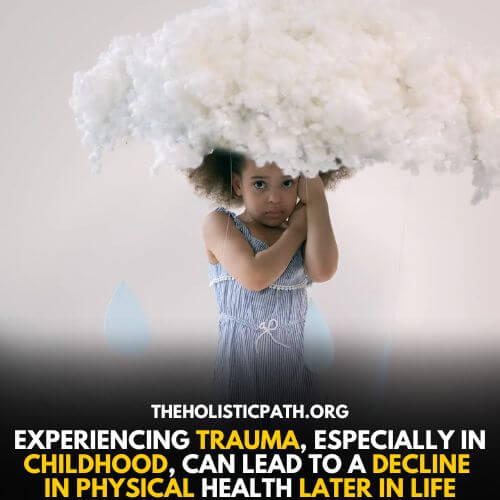
Additionally, trauma can also lead to generational trauma, which is passed down from one generation to the next. This is often seen in families who have experienced war or other forms of violence. Chronic stress and exposure to traumatic events can have a negative impact on physical health, making it important to seek help if you have experienced trauma.
Signs That Someone Is In The Cycle Of Trauma
Anyone can experience trauma, and it can happen at any age. Unfortunately, people who have experienced trauma often find themselves stuck in a cycle of trauma. There are some common signs that someone is in the cycle of trauma, which include:
- Exhibiting signs of anxiety, depression, or other mental health issues.
- Avoiding people or places that remind them of the trauma.
- Feeling on edge or easily startled.
- Difficulty sleeping or focusing.
- Irritability or outbursts of anger.
- Engaging in self-destructive behaviors, such as cutting or overeating.
- Having flashbacks or nightmares about the traumatic event.
- Avoiding anything that reminds them of the trauma.
- Feeling numb or disconnected from others.
If you see these signs in yourself or someone you care about, it’s important to seek help from a mental health professional. With treatment, it is possible to break the cycle of trauma and lead a healthy, happy life.
16 Ways To Break The Cycle Of Trauma
Trauma can be a difficult thing to overcome, but it is possible to break the cycle of trauma with the right support and resources. Here are 15 ways to get started:
1. Learn To Say No
One of the main ways we can break the cycle of trauma is by learning to say no when needed. This can be difficult, especially if we’ve been conditioned to please others or put their needs above our own. However, it’s essential to our well-being.
By setting boundaries and saying no when we need to, we’re taking care of ourselves and sending a message that we won’t tolerate being mistreated. This can be a powerful act that helps break the cycle of trauma and begin the healing process.
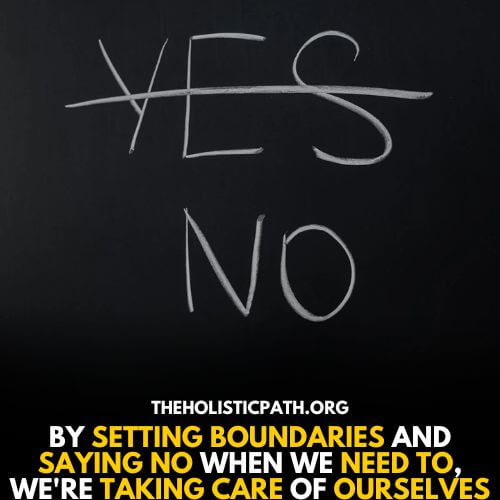
2. Connect With Others Who Have Gone Through Similar Experiences
When we go through trauma, it can be difficult to feel connected to others. We may feel like we’re the only ones who have ever experienced something like this. But when we reach out and connect with others who have gone through similar experiences, it can help to break the cycle of trauma.
By sharing our stories and connecting with others, we can begin to heal. There is great comfort and support to be found in talking to others who have experienced trauma.
3. Avoid Any Kind Of Self-Judgment Or Self-Blame
When we’ve experienced trauma, it’s common to feel like we’re to blame. We might judge ourselves for what happened or beat ourselves up for not being able to prevent it. However, this self-blame only serves to perpetuate the cycle of trauma.
By avoiding any self-judgment or self-blame, we can begin to break that cycle and start the healing process. Instead of focusing on what we could have done differently, we can focus on taking care of ourselves and trusting that we will be able to heal.
It’s important to remember that you are not responsible for the traumatic events that have occurred in your life.
4. Take Care Of Yourself Both Physically And Emotionally
Trauma can have a lasting effect on both your physical and emotional health. It can cause problems with sleep, concentration, and mood. It can also make you more likely to abuse substances or engage in risky behaviors. Taking care of yourself both physically and emotionally can help to break the cycle of trauma.
Eating healthy, getting regular exercise, and spending time with supportive people can all help you to feel better and cope with the effects of trauma. If you’re struggling to take care of yourself, talk to a therapist or counselor who can help you develop a plan to take care of your mind and body.
5. Express Your Feelings And Emotions In A Healthy Way
When we bottle up our emotions, it can lead to physical and mental health problems. It can also cause us to act out in unhealthy ways or become trapped in a cycle of trauma. Expressing our feelings and emotions in a healthy way can help to break this cycle.
It allows us to release pent-up emotions and can help us to process our experiences in a healthy way. This, in turn, can help us to heal and move on from traumatic experiences. So next time you’re feeling bottled up, don’t be afraid to let it out in a healthy way. Your mind and body will thank you for it.
6. Be Patient With Yourself
It takes time and effort to break the cycle of trauma and heal old wounds. Don’t expect to achieve progress overnight – be proud of every step you make along the way.
Being patient with yourself can help to break the cycle of trauma by allowing you to approach situations with more caution and care. This can prevent you from making decisions that could lead to further trauma, and allow you to heal from past trauma more effectively.
Additionally, being patient with yourself can help you to develop a stronger sense of self-compassion and self-worth. This can lead to feeling more content and at peace with yourself, which can in turn help to break the cycle of trauma.
7. Challenge Any Negative Thoughts Or Beliefs You May Have About Yourself
Trauma can be a difficult thing to overcome, but it is important to remember that you are not alone. Many people have experienced trauma, and there is help available. One way to begin the healing process is to challenge any negative thoughts or beliefs you may have about yourself. This can be difficult, but it is an important step in breaking the cycle of trauma.
Remember that you are strong and capable and that you can overcome anything. You are not defined by your trauma, and you can create a new future for yourself.
8. Talk About Your Traumatic Experiences
Talking about your traumatic experiences in a safe and supportive environment can help break the cycle of trauma. When you talk about your experiences, you can start to make sense of what happened and begin to process the emotions you’re feeling.

This can help you to move on from the trauma and start to heal. Talking about your experiences can also help you to feel less alone and more supported. You may find it helpful to talk to a therapist or counselor who can provide a safe space for you to share your story.
This could be with a therapist, a support group, or a friend who will listen without judgment.
9. Take Action To Improve Your Current Situation If Possible
When you’ve experienced trauma, it can be hard to feel like anything will ever get better. But it’s important to remember that you have the power to take action and make changes in your life. Even small steps can help break the cycle of trauma and begin the healing process.
So if you’re able, reach out for help, talk to a therapist, and start making positive changes in your life. You deserve to live a life free from trauma.
If there are things in your life that you don’t like or that are causing you stress, try to take steps to change them.
10. Focus On Living In The Present Moment As Much As Possible
Trauma can be a difficult cycle to break out of. One way to help is by living in the present moment as much as possible. This can help you to focus on the here and now, and not on past events.
It can also help you to become more mindful of your thoughts and emotions, and to respond to them in a more positive way. By living in the present moment, you can start to break the cycle of trauma and begin to lead a more peaceful and fulfilling life.
11. Try Not To Isolate Yourself From Others
Trauma can have a lasting impact on our lives, causing us to feel isolated and alone. However, reaching out to others and building supportive relationships can help to break the cycle of trauma. Connecting with others helps us to feel seen and valued, raising our self-esteem and increasing our sense of worthiness.
In addition, supportive relationships provide opportunities for healing and growth. As we learn to trust and care for others, we can also learn to trust and care for ourselves. Therefore, breaking the cycle of isolation is an important step in the healing process.
12. Make Sure You Get Regular Exercise
When you experience trauma, it can feel like you’re stuck in a cycle of anxiety and fear. But regular exercise can be a powerful tool for breaking that cycle. Exercise releases endorphins, which have mood-boosting effects.
It also helps to reduce stress and improve sleep. And when you feel better mentally, you’re less likely to fall into negative thinking and behavior patterns. So if you’re looking for a way to break the cycle of trauma, regular exercise is a great place to start.
13. Write About Your Experiences
Writing about your experiences can help break the cycle of trauma by giving you a chance to process what happened and to make sense of your emotions. It can also be a way to track your progress as you heal and to look back on when you feel like you’ve made some headway.
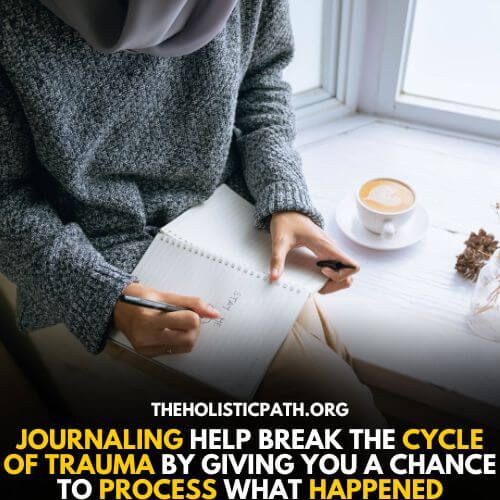
Additionally, journaling can provide an outlet for pent-up feelings and can be a form of self-care. Writing regularly can help you to feel more in control, more connected to yourself, and more hopeful about the future.
14. Be Mindful Of What You Eat And Drink
Some foods and drinks can aggravate symptoms associated with post-traumatic stress disorder (PTSD). When you are mindful of what you eat and drink, you are less likely to overeat or consume unhealthy foods and beverages. This can help to break the cycle of trauma by reducing your risk for obesity, heart disease, cancer, and other chronic conditions.
In addition, being mindful of what you eat and drink can help you to make healthier choices that support your overall health and well-being. When you are healthy and well-nourished, you are better able to cope with stress and recover from traumatic events. Therefore, being mindful of what you eat and drink is an important step in breaking the cycle of trauma.
15. See A Specialist
If you’re struggling with PTSD or another mental health condition related to trauma, seeing a specialist can help break the cycle of trauma. Trauma can have a big impact on your mental health, and it can be tough to break the cycle on your own.
But with the help of a professional, you can start to work through your trauma and find ways to cope with it. Professional help can make a big difference in your recovery from trauma.
16. Take Things One Day At A Time
When we’re dealing with trauma, it can feel like the weight of the world is on our shoulders. Every day can feel like a struggle just to get through. But one of the best things we can do for ourselves is to take things one day at a time.
Instead of trying to deal with everything all at once, we can focus on just getting through today. And then tomorrow, we can focus on getting through that day. Slowly but surely, we can start to break the cycle of trauma and move toward healing.
Takeaway
When someone experiences trauma, it can have a ripple effect that extends far beyond the individual. Trauma can be passed down from generation to generation, creating a cycle of pain and suffering. But it doesn’t have to be this way. Through awareness and understanding, we can break the cycle of trauma and create a new legacy of healing and hope.
